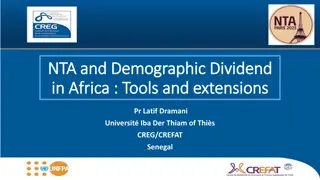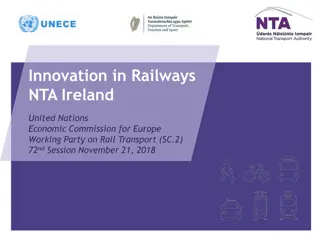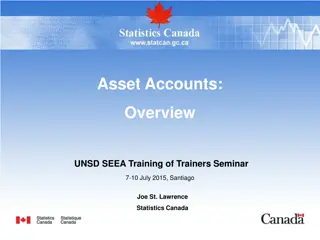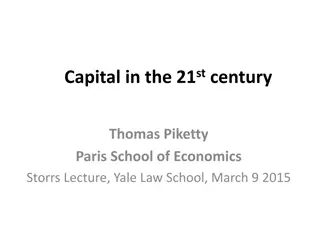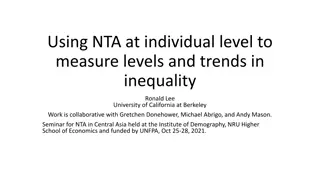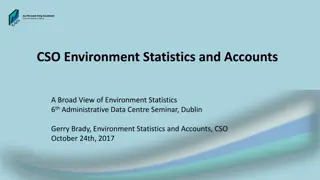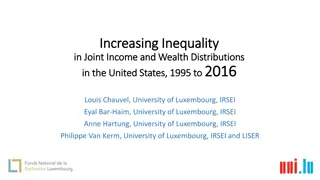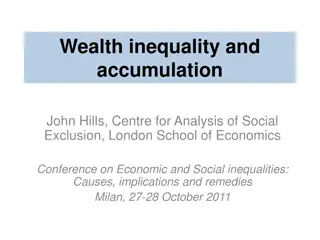Understanding Wealth Accounts: Challenges and Models in NTA
Wealth accounts in National Transfer Accounts (NTA) are vital for classifying wealth by sector and age group. Challenges in constructing wealth accounts include data availability and modeling transfers. Public and private asset transfers, revaluations, and capital transfers are crucial components to consider for a thorough accounting of wealth. Special issues related to public assets and the transfer of wealth between age groups pose additional complexities. Overall, wealth accounts provide insight into the distribution and changes in wealth over time.
Download Presentation

Please find below an Image/Link to download the presentation.
The content on the website is provided AS IS for your information and personal use only. It may not be sold, licensed, or shared on other websites without obtaining consent from the author. Download presentation by click this link. If you encounter any issues during the download, it is possible that the publisher has removed the file from their server.
E N D
Presentation Transcript
Outline What is wealth in NTA? (Ron) What are wealth accounts? What are the main challenges in constructing wealth accounts? Modelling public and private transfers (including capital transfers) (Miguel) Data availability (Michael)
What is wealth? Ron addresses this issue emphasizing transfer wealth.
NTA Wealth Accounts NTA wealth accounts classify wealth (assets and transfer wealth) by sector (public and private) and by age Wealth accounts consist of Opening balance or wealth at the beginning of the period Net changes for each age group/cohort during the period Closing balance or wealth at the end of the period
Simple NTA Private Asset Account Aggregate private assets by age Age 0 1 2 3 Total Opening balance 0 15 50 30 95 Net changes in assets 6.54 37.44 16.72 -30 30.7 Ending balance 0 6.54 52.44 66.72 125.7 Members of each age group have initial assets, net changes in their assets during the year, a birthday, and end up a year older with new assets at the end of the year.
With changes in assets elaborated Aggregate private assets by age Age 0 0 1 15 2 50 3 30 -30 -10 0.3 1.5 -21.8 66.72 Total Opening balance Net changes in assets Saving Other changes in volume Revaluations Capital transfers Ending balance 95 6.54 0 0 0 6.54 0 37.44 30 0.15 0.75 6.54 6.54 16.72 5 0.5 2.5 8.72 52.44 30.7 25 0.95 4.75 0 125.7 In standard models, we simplify using A(x,t)=A(x-1,t-1)+S(x,t). A complete accounting requires that we incorporate other sources of change in assets. Other changes in volume Natural disasters and uncompensated seizures Revaluations Change in asset prices, exchange rates, PV calculations Capital transfers Bequests and other capital transfers (household reclassifications)
Special issues related to public assets Public asset transfers arise as responsibility of age group (tax bill) shifts Over time older age groups transfer public assets to younger age groups Children including newborns have public assets (or debt) Other?
Issues related to transfer wealth Transfer wealth is prospective Based on expectations about what will happen in the future Calculation requires a model that captures how current transfers and capital transfers will change over time.
An NTA Model? Reconcile the imbalances that arise in public and private transfer systems because of changes in population age structure. Assess the implications of changes in public policy for macroeconomic outcomes. Explore the effects of demography on economic growth and standards of living. Earlier models (tau model) could be enhanced. Work at AGENTA. World Bank project. Wealth accounts are specific to a particular model simulation. Is it possible to have a standard model and a standard wealth account?
Issues related to transfer wealth Transfer wealth is prospective Based on expectations about what will happen in the future Calculation requires a model that captures how current transfers and capital transfers will change over time. Net changes in transfer wealth Transfer wealth is saved or dis-saved as cohorts receive benefits and pay taxes. Include in the flow account? Changes in public policy (other changes in volume?) Changes in PV calculations (revaluation)
Data Sources Changes in Wealth National statistical agencies UN System of National Accounts compilation IMF Government Finance Statistics (GFS) OECD Stat
Data Sources Opening (and Closing) Wealth National statistical agencies UN System of National Accounts compilation IMF Fiscal Monitor and GFS OECD Stat Picketty and Zucman (2013) http://piketty.pse.ens.fr/en/capitalisback
Data Availability Coverage Source Sectors Latest Country Opening (and Closing) Wealth Members* UN SNA MADT Public/Private 1997 2019** Members* IMF Fiscal Monitor (2014) Public only OECD Stat (2014) Public/Private 2013 Members Picketty-Zucman (2013) Public/Private 2011 9 High-Income Changes in Wealth Members* UN SNA MADT (2014) Public/Private 2012 Members* IMF GFS (2014) Public only 2012 OECD Stat (2014) Public/Private 2013 Members * Submitting members; ** Projected





